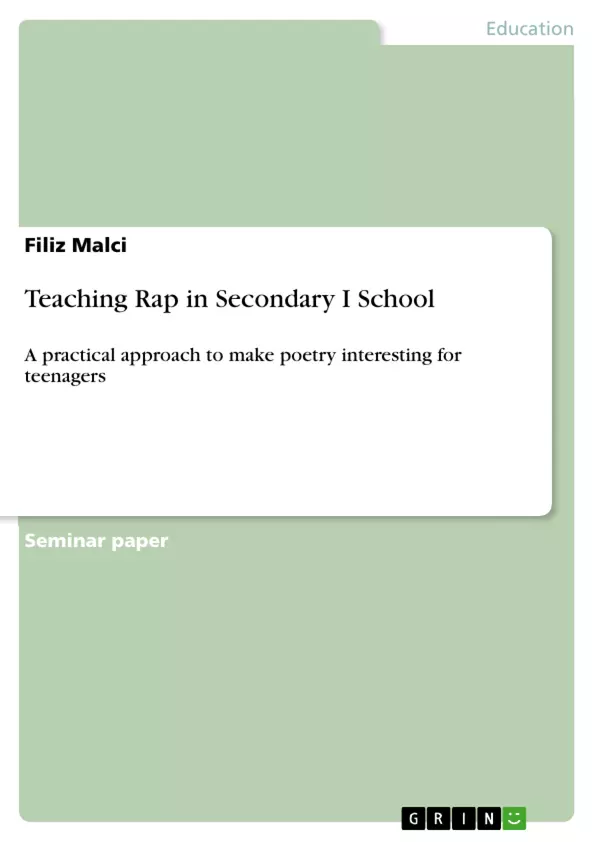The following term paper deals with rap as a form of poetry to be taught in a foreign English language classroom with the focus on a 10th grade of the Secondary I School.
The second chapter of this term paper analyzes the literary genre of poetry since it is fundamental for the comprehension of poems in general. The third chapter deals with rap as a form of poetry which provides a lifeworld reference for students. In order to understand the message behind rap poems it is necessary that students acquire knowledge about the development of rap.
In addition students should learn to apprehend rap as a form of poetry, which might initially not be obvious due to the informal speech style. The fourth chapter of this term paper explains the importance of teaching poetry in a foreign English language classroom with the focus on rap as a form of poetry. For this purpose the rap poems "The Rose that Grew from Concrete" and "Liberty Needs Glasses" by Tupac Shakur are taken into consideration for teaching a 10th grade of a Secondary I School in rap.
Inhaltsverzeichnis (Table of Contents)
- INTRODUCTION
- THE DEFINITION OF THE LITERARY GENRE OF POETRY
- THE DEFINITION OF RAP AS A FORM OF POETRY
- THE IMPORTANCE OF TEACHING POETRY IN A FOREIGN ENGLISH LANGUAGE CLASSROOM
- TEACHING RAP AS A FORM OF POETRY IN A 10TH GRADE OF A SECONDARY I SCHOOL
- THE ROSE THAT GREW FROM CONCRETE AND LIBERTY NEEDS GLASSES BY TUPAC SHAKUR AS EXAMPLES FOR TEACHING RAP IN A 10TH GRADE OF A SECONDARY I SCHOOL
Zielsetzung und Themenschwerpunkte (Objectives and Key Themes)
This term paper explores the use of rap as a form of poetry in a foreign English language classroom, focusing on a 10th grade of the Secondary I School. The primary aim is to demonstrate how rap can be effectively integrated into poetry lessons, making the subject matter more engaging and relevant for students. The paper examines the definition of poetry, the evolution of rap as a poetic form, and the benefits of teaching poetry in a foreign language context.
- The definition and characteristics of poetry as a literary genre
- The emergence and development of rap as a form of poetry
- The pedagogical value of teaching poetry in a foreign language classroom
- The application of rap poetry in engaging students and enhancing their understanding of English
- The use of specific rap poems by Tupac Shakur as practical examples for teaching rap in a 10th grade English class
Zusammenfassung der Kapitel (Chapter Summaries)
- Introduction: This chapter introduces the topic of teaching rap as a form of poetry in secondary education. It highlights the challenges of engaging students with poetry and proposes rap as a potential solution. The chapter emphasizes the importance of relating poetry to students' everyday experiences and interests.
- The Definition of the literary genre of Poetry: This chapter provides a broad overview of poetry as a literary genre. It explores the difficulty of defining poetry precisely due to its diverse forms and functions. The chapter delves into key features of poetry, including stylistic devices, structural elements, and the role of ambiguity.
Schlüsselwörter (Keywords)
The key concepts and terms covered in this paper include poetry, rap, teaching poetry, foreign language classroom, secondary education, Tupac Shakur, stylistic devices, poetic forms, and engaging students.
- Quote paper
- Filiz Malci (Author), 2019, Teaching Rap in Secondary I School, Munich, GRIN Verlag, https://www.grin.com/document/465739



